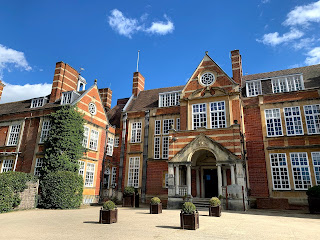Anyone who's read the last article and knows where I live may be calling my a hypocrite.
Our house, though Georgian in its inspiration, sprang from historic farmland in 2012. No matter how
beautifully designed or carefully landscaped, our neighbourhood could be a proof point in the over-expansion of Basingstoke that I just bemoaned. Even though the modern incomers are more likely to be seeking escape from London's crazy housing prices than its grinding poverty, the village of Sherfield-on-Loddon still objected strenuously in 2004 when bulldozers prepared to replace ploughs on Taylor's Farm.
These days the re-christened "Sherfield Park" has more people (about 2,000) than the village it lies beside. The people of Sherfield-on-Loddon have grown accustomed to us, and no doubt appreciate the income flowing in to local services. What other village of 1,500 people do you know that can support three pubs?
In the heart of the village you'll find the White Hart (above) and the Four Horseshoes (below).
Across the busy road to Reading (the A33) is the Longbridge Mill. Though architecturally the most interesting, housed in a rambling and well-preserved Georgian mill complex, it's actually the one with the least character given its chain pub, "family-friendly" atmosphere.
The Horseshoes is the only pub I know to retain its original "skittle alley", while the Hart is probably winning the stakes at the moment on the culinary front. This can change every time someone gets or loses a chef, of course. The Horseshoes made a past appearance here as a proper gastropub celebrating local provenance; these days they do Thai take-away.
The trio forms a picturesque architectural centrepiece of a village six miles northwest of Basingstoke. For most residents these days it's a quick hop into town for shopping or the train station, but for much of the village's long history residents' lives would have been anchored here, with only the occasional trip to sell produce at Basingstoke's weekly market or interact with local magistrates.
For most of its long history, it would have been a farming village benefiting from the rich clay soils next to the exquisitely pretty river Loddon. They no doubt would have enjoyed its trout, too ... though these days fishing rights are fiercely protected and access is limited.
The village's houses would have been scattered around a series of fields held in common for grazing. Though most of Sherfield-on-Loddon's housing these days was is less than 100 years old, the thatched cottage below gives an idea of how most of the village might have looked in 1838 when the Duke of Wellington bought the "lord of the manor" title to go with his new estate just up the road at Stratfield Saye. (Check out an earlier piece on Stratfield Saye
here.)
Some of that old communal green space is now two picturesque duck ponds.
Some has been set aside for recreational space ... there's a cricket pitch and tennis courts. And some remains a slightly wild green area for rambling. Though the only grazing animals you're likely to meet are these friendly wild boar.
Another striking feature of the Sherfield-on-Loddon is its Victorian village hall.
Up through Victorian times, there were probably only 40 homes scattered around all this green space. Things changed in 1917 when the Ministry of Defence purchased land next to the village for an enormous ordnance depot. It boosted employment possibilities and numbers in the village.
The most visible sign of WWI, however, is the inevitable war memorial. It wasn't until I really started paying attention to these memorials in every village, looking at the number of names and thinking about the percentage of population that they probably represented, that I truly understood why that war still looms so large in British memory.
Here are some of more charming village houses.
And though modern developments (like mine) are eating up the farm fields surrounding the village, you can still get lost down leafy back lanes and discover scenes like these:
Sherfield-on-Loddon has its share of grand houses, too. The showiest is Buckfield, a grand Victorian mansion sitting on Medieval foundations. It became a school after WW2.
More my style is the Georgian Sherfield Court, still in private hands and sitting next to the parish church.
The parish church of St. Leonards is unusual in being a mile outside of the main village, rather than at its centre. It's a lovely Victorian building with Medieval roots.
We were house hunting in the village proper before settling in Sherfield Park, but the real irony of Basingstoke's hyper-growth is that historic properties ... and let's call that anything before WW2 ... have become highly desirable and go for a premium. Most of the housing on the market is from the '70s through the early part of this century, lacking character and reaching the age where things need to be replaced. Our best option was to buy new, in a place inspired by the old. At least in our corner of the county, we can rest assured that local councils and residents alike are fighting to maintain the charm we've managed to retain.




















1 comment:
Lovely read Ellen, thank you. My Mum sometimes came to stay with us, when we lived in Sheffield Park, we used to collect conkers from the chestnut trees alongside the football and cricket pitches in Autumn. (Her weapon of choice for anti-spider treatments!) We had many a potter around the village and tea and cakes in the Post Office tea-rooms. Remembering Spring daffodils in the woods and great drifts of elderflowers in Summer. Fab for making elderflower champagne! Brought back some lovely memories of her. :-)
Post a Comment